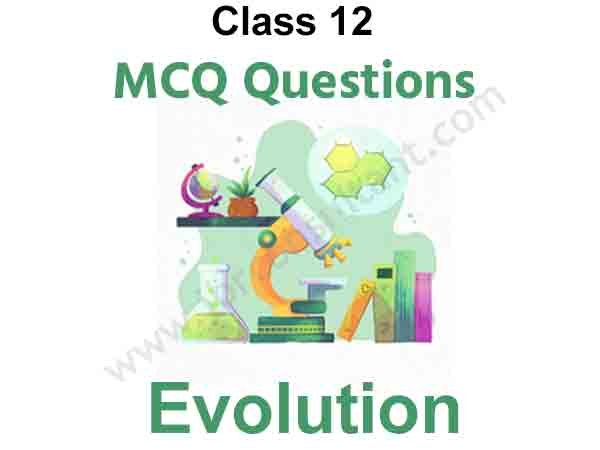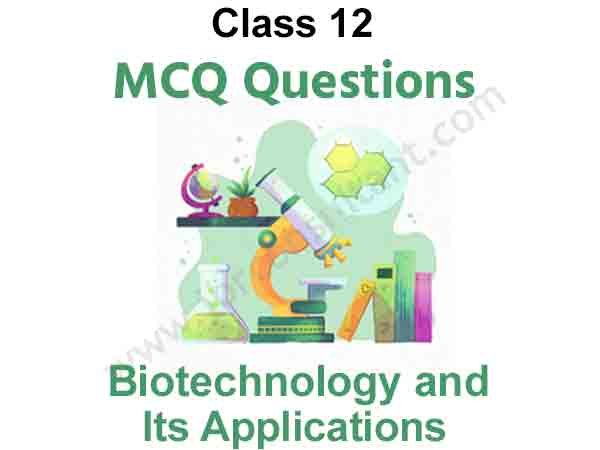Evolution Class 12 MCQ is one of the best strategies to prepare for the CBSE Class 12 Board exam. If you want to complete a grasp concept or work on one’s score, there is no method except constant practice. Students can improve their speed and accuracy by doing more MCQ on Evolution Class 12, which will help them all through their board test.
Evolution Class 12 MCQ Questions with Answers
Class 12 Biology MCQ with answers are given here to chapter 7 Evolution. These MCQs are based on the latest CBSE board syllabus and relate to the latest Class 12 Biology syllabus. By Solving these Evolution Class 12 MCQ, you will be able to analyze all of the concepts quickly in the chapter and get ready for the Class 12 Annual exam.
Learn MCQ on Evolution Class 12 PDF free download according to the latest CBSE and NCERT syllabus. Students should prepare for the examination by solving CBSE Class 12 Evolution class 12 MCQ with answers given below.
Question 1. The idea of mutations was brought forth by
(a) Hugo de Vries who worked on evening primrose
(b) Gregor Mendel who worked on Pisum sativum
(c) Hardy-Weinberg who worked on allele frequencies in a population
(d) Charles Darwin who observed a wide variety of organisms during sea voyage.
Answer
A
Question 2. From his experiments, S.L. Miller produced amino acids by mixing the following in a closed flask.
(a) CH4, H2, NH3 and water vapor at 800°C
(b) CH3, H2, NH4 and water vapor at 800°C
(c) CH4, H2, NH3 and water vapor at 600°C
(d) CH3, H2, NH3 and water vapor at 600°C
Answer
A
Question 3. Homo sapiens have evolved in
(a) Paleocene
(b) Pleistocene
(c) Oligocene
(d) Holocene
Answer
D
Question 4. Which of the following amino acids was not found to be synthesised in Miller’s experiment?
(a) Alanine
(b) Glycine
(c) Aspartic acid
(d) Glutamic acid
Answer
D
Question 5. Reason of diversity in living being is
(a) mutation
(b) long term evolutionary change
(c) gradual change
(d) short term evolutionary change.
Answer
B
Question 6. Most abundant organic compound on earth is
(a) protein
(b) cellulose
(c) lipids
(d) steroids.
Answer
B
Question 7. Embryological support for evolution was disapproved by
(a) Karl Ernst von Baer
(b) Alfred Wallace
(c) Charles Darwin
(d) Oparin.
Answer
A
Question 8. The correct sequence for the manufacture of molecules/organic compounds on the primitive earth is
(a) NH3, nucleic acid, protein and carbohydrate
(b) protein, carbohydrate, water and nucleic acid
(c) NH3, protein, carbohydrate and nucleic acid
(d) NH3, water, nucleic acid and protein.
Answer
D
Question 9. Flippers of penguins and dolphins are examples of
(a) adaptive radiation
(b) convergent evolution
(c) industrial melanism
(d) natural selection.
Answer
B
Question 10. Theory of inheritance of acquired characters was given by
(a) Wallace
(b) Lamarck
(c) Darwin
(d) De Vries.
Answer
B
Question 11. Among the following sets of examples for divergent evolution, select the incorrect option.
(a) Forelimbs of man, bat and cheetah
(b) Heart of bat, man and cheetah
(c) Brain of bat, man and cheetah
(d) Eye of octopus, bat and man
Answer
D
Question 12. According to fossils discovered up to present time origin and evolution of man started from
(a) France
(b) Java
(c) Africa
(d) China.
Answer
C
Question 13. Industrial melanism is an example of
(a) mutation
(b) Neo-Lamarckism
(c) Neo-Darwinism
(d) natural selection
Answer
D
Question 14. “Homo sapiens” implies
(a) human race
(b) human beings
(c) modern man
(d) none of these
Answer
B
Question 15. Darwin in his “Natural Selection Theory” did not believe in any role of which one of the following in organic evolution ?
(a) Parasites and predators as natural enemies
(b) Survival of the fittest
(c) Struggle for existence
(d) Discontinuous variations
Answer
D
Question 16. When two species of different genealogy come to resemble each other as a result of adaptation, the phenomenon is termed
(a) microevolution
(b) co-evolution
(c) convergent evolution
(d) divergent evolution.
Answer
C
Question 17. In the case of peppered moth (Biston betularia) the black-coloured form became dominant over the light-coloured form in England during industrial revolution. This is an example of
(a) appearance of the darker coloured individuals due to very poor sunlight
(b) protective mimicry
(c) inheritance of darker colour character acquired due to the darker environment
(d) natural selection whereby the darker forms were selected.
Answer
D
Question 18. In a population of 1000 individuals 360 belong to genotype AA, 480 to Aa and the remaining 160 to aa. Based on this data, the frequency of allele A in the population is
(a) 0.4
(b) 0.5
(c) 0.6
(d) 0.7.
Answer
C
Question 19. Which of the following is the relatively most accurate method for dating of fossils?
(a) Radio-carbon method
(b) Potassium-argon method
(c) Electron-spin resonance method
(d) Uranium-lead method
Answer
C
Question 20. Similarities in organism with different genotype indicates
(a) microevolution
(b) macroevolution
(c) convergent evolution
(d) divergent evolution.
Answer
C
Whoever needs to take the CBSE Class 12 Board Exam should look at this MCQ. To the Students who will show up in CBSE Class 12 Biology Board Exams, It is suggested to practice more and more questions. Aside from the sample paper you more likely had solved. These Evolution Class 12 MCQ are ready by the subject specialists themselves.
Question 21. Which one of the following describes correctly the homologous structures ?
(a) Organs with anatomical similarities, but performing different functions
(b) Organs with anatomical dissimilarities, but performing same function
(c) Organs that have no function now, but had an important function in ancestor
(d) Organs appearing only in embryonic stage and disappearing later in the adult
Answer
A
Question 22. Which of the following was most similar to modern man?
(a) Java man
(b) Neanderthal man
(c) Homo habilis
(d) Cro-Magnon man
Answer
D
Question 23. At a particular locus, frequency of A allele is 0.6 and that of a is 0.4. What would be the frequency of heterozygotes in a random mating population at equilibrium?
(a) 0.36
(b) 0.16
(c) 0.24
(d) 0.48
Answer
D
Question 24. Which of the following are homologous organs?
(a) Wings of bird and hands of human
(b) Nails of human being and claws in animals
(c) Wings of bird and wings of insect
(d) Wings of bat and wings of cockroach
Answer
A
Question 25. Humming birds and Hawk illustrate
(a) convergent evolution
(b) homology
(c) adaptive radiation
(d) parallel evolution.
Answer
C
Question 26. Which of the following isotopes is most dangerous to Homo sapiens?
(a) Phosphorus-32
(b) Strontium-90
(c) Caesium-137
(d) Iodine-131
Answer
B
Question 27. Which of the following had the smallest brain capacity?
(a) Homo neanderthalensis
(b) Homo habilis
(c) Homo erectus
(d) Homo sapiens
Answer
B
Question 28. The presence of gill slits, in the embryos of all vertebrates, supports the theory of
(a) metamorphosis
(b) biogenesis
(c) organic evolution
(d) recapitulation.
Answer
D
Question 29. The finch species of Galapagos islands are grouped according to their food sources. Which of the following is not a finch food?
(a) Carrion
(b) Insects
(c) Tree buds
(d) Seeds
Answer
A
Question 30. Forthcoming generation are less adaptive than the parental generation due to
(a) natural selection
(b) mutation
(c) genetic drift
(d) adaptation.
Answer
B
Question 31. Common origin of man and chimpanzee is best shown by
(a) binocular vision
(b) chromosome number
(c) dental formula
(d) cranial capacity.
Answer
D
Question 32. Adaptive radiation refers to
(a) evolution of different species from a common ancestor
(b) migration of members of a species to different geographical areas
(c) power of adaptation in an individual to a variety of environments
(d) adaptations due to geographical isolation.
Answer
A
Question 33. A population is in Hardy- weinberg equilibrium for a gene with only two alleles. If the gene frequency of an allele A is 0.7, the genotype frequency of Aa is
(a) 0.21
(b) 0.42
(c) 0.36
(d) 0.7
Answer
B
Question 34. The cranial capacity was largest among the
(a) Peking man
(b) African man
(c) Java Ape man
(d) Neanderthal man
Answer
D
Question 35. In a species, the weight of newborn ranges from 2 to 5 kg. 97% of the newborn with an average weight between 3 to 3.3 kg survive whereas 99% of the infants born with weights from 2 to 2.5 or 4.5 to 5 kg die. Which type of selection process is taking place?
(a) Cyclical selection
(b) Directional selection
(c) Stabilising selection
(d) Disruptive selection
Answer
C
Question 36. Which one of the following changes involved is irrelevant, in the evolution of man?
(a) Perfection of hand for tool making
(b) Change of diet from hard nuts and hard roots to soft food
(c) Loss of tail
(d) Increase in the ability to communicate with others and develop community behaviour
Answer
B
Question 37. Evolutionary convergence is development of
(a) common set of characters in group of different ancestry
(b) dissimilar characters in closely related groups
(c) common set of characters in closely related groups
(d) random mating.
Answer
A
Question 38. Which of the following cannot be explained by Lamarckism?
(a) Absence of lips in snakes
(b) Long neck of giraffe
(c) Degeneration of visual apparatus in cave dwellers
(d) Dull progeny of noble laureate
Answer
D
Question 39. Which of the following statements is correct about the origin and evolution of men ?
(a) Agriculture came around 50,000 years back.
(b) The Dryopithecus and Ramapithecus primates existing 15 million years ago, walked like men.
(c) Homo habilis probably ate meat.
(d) Neanderthal men lived in Asia between 1,00,000 and 40,000 years back.
Answer
D
Question 40. Jurassic period of the Mesozoic era is characterised by
(a) flowering plants and first dinosaurs appear
(b) gymnosperms are dominant plants and first birds appear
(c) radiation of reptiles and origin of mammal like reptiles
(d) dinosaurs become extinct and angiosperms appear.
Answer
B

You can easily get good marks If you study with the help of Evolution Class 12 MCQ. We trust that information provided is useful for you. NCERT MCQ on Evolution Class 12 PDF Free Download would without a doubt create positive results.
We hope the information shared above in regards to MCQs on Evolution in Organisms Class 12 with Answers has been helpful to you. if you have any questions regarding CBSE MCQ on Evolution Class 12 PDF, write a comment below and we will get back to you as soon as possible.
Frequently Asked Question (FAQs)
How many MCQ questions are there in CLass 12 chapter 7 Biology?
In Class 12 chapter 7 Biology, we have provided 40 Important MCQ Questions, But in the future, we will add more MCQs so that you can get good marks in the Class 12 exam.
Can we score good marks in Evolution Class 12 Biology with the help of MCQ Questions?
Yes, MCQ Question is one of the best strategies to make your preparation better for the CBSE Board Exam. It also helps to know the student’s basic understanding of each chapter. So, You can easily score good marks in the Class 12 BIology exam.

